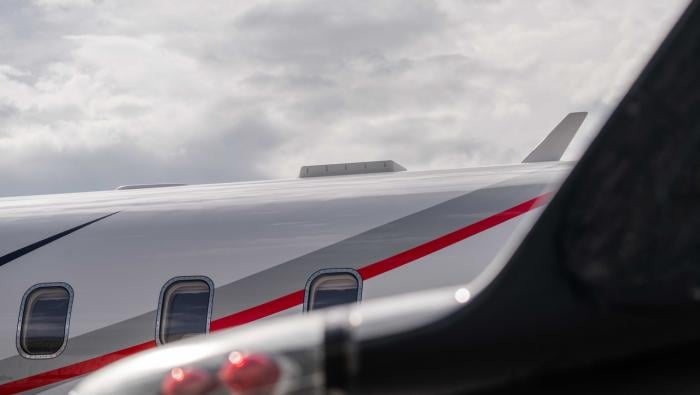Buckle up for safety! The long-running ad campaign that got us all to wear our seat belts when driving is just as relevant to airplanes as cars, and children as well as adults. DOT-mandated driving laws require young children to be not only restrained by seat belts but also ensconced in approved car seats. When it comes to flying in an airplane, however, the most vulnerable of our children, those under the age of two, do not have to be restrained at all. Many parents who would never think of driving with an infant or toddler unsecured in the backseat of a car seem unaware of the safety risk in an aircraft. And if you’re thinking that it’s because they don’t want to pay for an extra seat, think again. Many people I’ve spoken with say that if it were unsafe for a child to fly unrestrained, the FAA wouldn’t allow it. Even people flying business aircraft with their families who have the means to provide appropriate restraints don’t always have child safety seats for their children.
Although everyone in aviation knows that a parent’s arms, no matter how strong, are inadequate to harness a child in the event of violent turbulence or rapid deceleration, the FAA apparently still does not see fit to mandate safety seats. Unrestrained, a child can become an uncontrolled flying object in the cabin with potentially catastrophic effect. A survivable accident could result in the serious injury or even death of an unsecured child. Speculative? Tell that to the parents who have survived a crash only to learn that their infant-in-arms was not so lucky.
The accident that finally drove this tragic point home to the NTSB was the July 2, 1994, USAir DC-9 accident in Charlotte, N.C. Two mothers on that fateful flight were holding their daughters (both under the age of two) on their laps. When the airplane experienced a powerful microburst on approach to Charlotte, causing it to land in a wooded area just short of the runway, the violent gyrations of the aircraft were too much for the two parents with unrestrained infants. While both mothers survived the crash relatively unscathed, their baby daughters were not so fortunate. One died on impact and one was severely injured. According to the NTSB report of the accident, the mother of the child who was killed stated that she was unable to maintain a secure hold on her child during the impact. It doesn’t take a physicist to understand that the g-forces from a hurtling aircraft would make it nearly impossible to hold onto a lap child.
As a result of this accident and the ensuing NTSB investigation, the Board recommended to the FAA in 1995 that children under the age of two be restrained on takeoff, landing and during turbulence. While the FAA conducted tests of child safety restraints, it failed to take any action. The NTSB added child safety restraints to its Most Wanted list in 1999. Years of FAA stalling and inaction followed. Nothing was done to implement this urgent safety recommendation. And then, inexplicably, and perhaps driven by a perverse need to tidy up its records, the NTSB took child safety restraints off its Most Wanted list in 2006, closing the recommendation as unacceptable action by the FAA.
Why would the FAA fail to take action to protect the only airplane occupants allowed to fly unrestrained? Even a coffee pot needs to be restrained during certain phases of flight. And why would the Safety Board cave in to FAA inaction by taking child safety restraints off its Most Wanted list? If a recommendation is a critical safety issue, the NTSB should never take it off its Most Wanted list until it is implemented. While there’s no movement that I am aware of at the Board to reinstate this recommendation, it is heartening to read that Board chair Debbie Hersman is convening a safety forum on the issue of child safety restraints.
Much of the credit for reviving the attention on this safety recommendation goes to Jan Lohr. She has been an untiring advocate for child safety restraints since she witnessed first-hand the tragedy of an unrestrained infant. Lohr was a flight attendant on United Flight 232, the DC-10 that lost all its hydraulics after an engine exploded. A 22-month-old child died when his mother–who survived–was unable to restrain him while the aircraft crashed and split apart in an Iowa cornfield on July 19, 1989.
I first met Lohr when I was an NTSB member and she was recruiting supporters for her aviation safety initiatives. While we agreed on many cabin-safety initiatives, the one we were both most passionate about was child safety restraints. Our passions were born from being first-hand witnesses to tragic aircraft accidents, she because of the Sioux City accident and I because of the 1994 Charlotte crash. I was the lead on-scene accident investigator for the IAM, USAir’s mechanics’ union, on that crash. An image that will always haunt me is the fireman carrying out the remains of the dead toddler, the child a mother could not restrain with her bare arms. To read
more about child restraint systems, visit www.ainonline.com/child_restraints. n
The opinions expressed in this column are those of the author and not necessarily endorsed by AIN.







